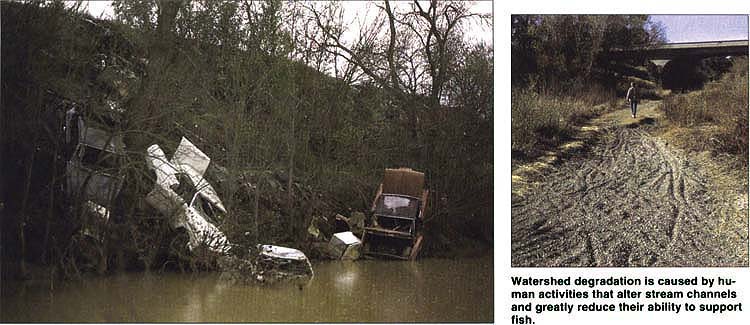All Issues
Sidebar: The decline of sea-run fishes in California: An ongoing tragedy
Publication Information
California Agriculture 49(6):74-74. https://doi.org/10.3733/ca.v049n06p74
Published November 01, 1995
PDF | Citation | Permissions
Abstract
Abstract Not Available – First paragraph follows: California has the southernmost West Coast populations of sea-run or “anadromous” fish, which spawn in fresh water but spend part of their lives in the ocean. The 13 anadromous fish species native to California include chinook salmon, steelhead trout, river lamprey, white sturgeon and longfin smelt.
Full text
Watershed degradation is caused by human activities that alter stream channels and greatly reduce their ability to support fish.
California has the southernmost West Coast populations of sea-run or “anadromous” fish, which spawn in fresh water but spend part of their lives in the ocean. The 13 anadromous fish species native to California include chinook salmon, steelhead trout, river lamprey, white sturgeon and longfin smelt.
In California, pink salmon have gone extinct and most remaining fish are declining. At least 10 species seem to meet state criteria for threatened species (Moyle et al. 1996.) For example, chum salmon have been reduced to three tiny populations in Northern California, and coho salmon with probably less than 5,000 wild fish in scattered populations are being considered for listing as a federally threatened species. In addition, California is on the verge of losing a number of distinct runs of the more abundant species. For example, winter run chinook salmon in the Sacramento River are listed as an endangered species, while Sacramento spring run and late fall run chinook salmon are down to a few thousand fish. In Southern California, the southern steelhead has disappeared from most of the now-urbanized streams that used to support it.
Not surprisingly, once valuable sport, commercial and Native American subsistence fisheries for these anadromous species have all but disappeared. While perhaps a million chinook salmon spawned in Central Valley streams at the turn of the century, by 1992 the spawning population was down to 128,000. Many of these chinook salmon were returnees to hatcheries and are genetically and behaviorally different from wild fish. Likewise, coho salmon have declined from about 400,000 in the 1940s to about 30,000 today, and only 5,000 are of wild origin.
Hatchery-raised fish were intended to keep wild populations from declining. But, arguably, hatcheries have made the problems worse for salmon and steelhead and done nothing for species that are not cultured.
The biggest causes of anadromous fish decline are dams, water diversions and watershed degradation. Dams and diversions block access to the spawning areas above them and change the quality of the water and habitat below the dams. In the Central Valley, for example, salmon once had access to several thousand miles of spawning habitat, today they have access to less than 300 miles. Watershed degradation is caused by logging, agriculture, grazing, urbanization and other human activities that alter stream channels and greatly reduce their ability to support fish. When anadromous fish also face overfishing and natural disasters such as drought, their populations can plunge downward rapidly.
Restoration of California's anadromous fishes will require different strategies for each species and often for each run within each species. The key for most species, however, either lies in increasing water releases below dams or in restoring watersheds that support spawning streams. Because activities such as logging, mining, grazing and urbanization have degraded many spawning streams severely, restoration will require not only active restoration programs (such as watershed reforestation and removal of roads from riparian areas), but also changes in the way we presently behave in watersheds (e.g., logging and grazing practices).
Further reading
Moyle P.S., Yoshiyama R.M., Wickramanayaka E., Williams. J.E.. Fish Species of Special Concern in California. 1996. California Department of Fish and Game, Sacramento. (in press). doi:10.2307/3431890 https://doi.org/doi:10.2307/3431890





